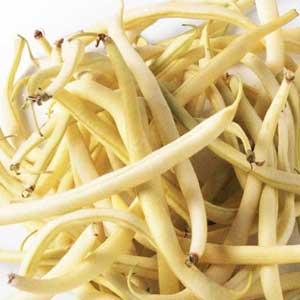Garbanzo beans, also called chickpeas, produce bushy plants that need 65 to 100 warm days. When dried, the nutty-tasting beans are good baked or cooked and chilled for use in salads. Great Northern white beans are most popular dried and eaten in baked dishes. In short-season areas, you can harvest and eat them as fresh shell beans in only 65 days. Bush-type Great Northerns are extremely productive. yelllow beansHorticultural beans are also known as shell, wren's egg, bird's egg, speckled cranberry, or October beans. Both pole and bush types produce a big harvest in a small space and mature in 65 to 70 days. Use the very young, colorful, mottled pods like snap beans, or dry the mature, nutty, red-speckled seeds. Kidney beans require 100 days to mature but are very easy to grow. Use these red, hearty-tasting dried seeds in chili, soups, stews, and salads. Lima beans, including types called butter beans or butter peas, are highly sensitive to cool weather; plant them well after the first frost. Bush types take 60 to 75 days to mature. Pole types require 90 to 130 days, but the vines grow quickly and up to 12 feet long. Limas are usually green, but there are also some speckled types. Use either fresh or dried in soups, stews, and casseroles. Mung beans need 90 frost-free days to produce long, thin, hairy, and edible pods on bushy 3-foot plants. Eat the small, yellow seeds fresh, dried, or as bean sprouts. Pinto beans need 90 to 100 days to mature. These large, strong plants take up a lot of space if not trained on poles or trellises. Use fresh like a snap bean, or dry the seeds. Scarlet runner beans produce beautiful climbing vines with scarlet flowers. The beans mature in about 70 days. Cook the green, rough-looking pods when they are very young; use the black-and red-speckled seeds fresh or dried. Snap beans are also known as green beans. While many growers still refer to snap beans as string beans, a stringless cultivar was developed in the 1890s, and few cultivars today have to be stripped of their strings before you eat them. Most cultivars mature in 45 to 60 days. This group also includes the flavorful haricots verts, also called filet beans, and the mild wax or yellow beans. For something unusual, try the yard-long asparagus bean. Its rampant vines can produce 3-foot-long pods, though they taste best when 12 to 15 inches long. Once the pods have passed their tender stage, you can shell them, too. Soldier beans, whose vinelike plants need plenty of room to sprawl, are best suited to cool, dry climates. The white, oval-shaped beans mature in around 85 days. Try the dried seeds in baked dishes. Garden cultivars of soybeans, also called edamame, are ready to harvest when the pods are plump and green. Boil the pods, then shell and eat the seeds. Or, you can let the pods mature and harvest as dry beans. Try 'Early Hakucho', 'Butterbean', and other varieties. The bush-type plants need a 3-month growing season but are tolerant of cool weather.
-
- Categories
- Other
- Fruits Farming
- Vegetable Farming
- Livestock Farming
- Rice / Wheat
- Beans Farming
- Nuts Farming
- Farming News
- Stone Fruits
- Fish Farming
- Poultry Farming
- Farming Equipment
- Farm Products
- Vineyard / Winery
- Food & Drink
- Event
- Restaurants
- Art & Design
- Enjoyment
- For Home
- Decoration
- Business Services
- Great Ideas
- Fashion
- Beauty & Health
- New
- Popular
- Gifts
- Videos
- Help / Contact Us
- Terms & Privacy
- What is FarmTerest


